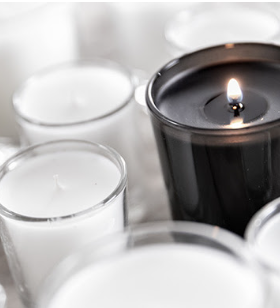Scented candles are more than just a source of fragrance; they are a blend of art and science, combining the right ingredients and techniques to create a perfect sensory experience. The craft of candle-making has evolved over centuries, with modern manufacturers employing innovative techniques to enhance the quality and appeal of their products. This blog delves into the art of crafting Scented candle manufacturer, sharing techniques and tips from top manufacturers that can inspire both hobbyists and professionals alike.
1. Understanding the Basics: Wax, Wick, and Fragrance
1.1. Choosing the Right Wax
The choice of wax is foundational in candle-making, as it affects the burn time, fragrance throw, and overall quality of the candle. Common waxes include:
- Soy Wax: A natural, renewable resource that burns cleanly and has a good scent throw.
- Paraffin Wax: A popular choice for its affordability and versatility, offering a strong scent throw.
- Beeswax: Known for its natural honey scent and long burn time, it’s an eco-friendly option.
- Coconut Wax: A luxurious option, often blended with other waxes for a smooth, creamy texture.
Each wax type has unique properties, and some manufacturers blend different waxes to achieve desired characteristics in terms of scent throw, texture, and burn quality.
1.2. Selecting the Perfect Wick
The wick plays a crucial role in the candle’s burn performance. The right wick ensures a consistent flame, minimal soot, and an even burn. Key factors to consider include:
- Material: Cotton wicks are common, but wood wicks offer a crackling sound and unique aesthetic.
- Size: The wick size must match the candle’s diameter; too small and the flame will be weak, too large and the candle may burn too quickly or unevenly.
- Coating: Some wicks are coated with wax to help them stay straight during the pouring process.
1.3. Crafting the Scent
Fragrance oils and essential oils are used to scent candles. The fragrance concentration and type of oil can significantly impact the candle’s aroma. Top manufacturers often use a blend of fragrance and essential oils to create complex scent profiles. When crafting a scent, consider:
- Top, Middle, and Base Notes: A well-balanced fragrance has a blend of these notes to create a layered experience.
- Fragrance Load: This refers to the percentage of fragrance oil relative to the wax. A higher load results in a stronger scent throw but must be balanced to avoid issues with burning.
2. Techniques in Scented Candle Crafting
2.1. The Pouring Process
The pouring process is a critical step in candle-making. The temperature of the wax, the timing, and the method can all affect the final product. Techniques include:
- Single Pour: Ideal for smaller candles, where the wax is poured once and left to set.
- Double Pour: Used for larger candles to prevent sinkholes and ensure an even surface. The first pour sets the base, and the second pour fills any voids and smooths the top layer.
- Cold and Hot Pouring: Depending on the wax type, candles can be poured at different temperatures. Hot pouring often ensures better adhesion to the container, while cold pouring can help with smoother surfaces and reduce frosting in soy candles.
2.2. Curing and Testing
Curing allows the fragrance to fully integrate with the wax, often taking up to two weeks. During this time, the candle should be kept in a stable, cool environment. Testing the candle after curing is crucial to ensure a consistent burn and fragrance throw. This involves:
- Burn Tests: Checking the wick’s performance, ensuring it burns evenly without excessive soot or tunneling.
- Fragrance Throw Tests: Evaluating both the cold throw (scent when the candle is unlit) and the hot throw (scent when the candle is burning).
2.3. Finishing Touches
Once the candle has cured, the final touches can enhance its appeal. This includes trimming the wick, cleaning the container, and adding labels. Top manufacturers often focus on aesthetic details, such as decorative lids, embossing, or unique packaging, to elevate the candle’s presentation.
3. Advanced Techniques and Innovations
3.1. Layered Candles
Creating layered candles involves pouring different colors or scents in successive layers. This technique requires careful timing and temperature control to prevent the layers from mixing. Layered candles can provide a visual and olfactory experience, with each layer offering a distinct color and fragrance.
3.2. Embedded Objects
Some candles feature embedded objects, such as dried flowers, herbs, or crystals. These objects can add aesthetic appeal and are often placed near the surface for visibility. Care must be taken to ensure these additions are safe and do not interfere with the candle’s burn.
3.3. Crackling Wood Wicks
Wood wicks add a crackling sound reminiscent of a fireplace, enhancing the sensory experience. They require specific care during the manufacturing process, including ensuring the wick is correctly centered and secured. Wood wicks often need to be soaked in oil or wax before use to ensure an even burn.
3.4. Color Changing and Scent Changing Candles
Innovative candles can change color or scent as they burn. Color-changing candles use special dyes that react to heat, while scent-changing candles have different fragrance layers that release sequentially. These advanced techniques require precise control and high-quality materials.
4. Tips from Top Manufacturers
4.1. Consistency is Key
Maintaining consistency in fragrance, color, and burn quality is crucial for brand reputation. This involves meticulous attention to detail, from sourcing high-quality materials to maintaining consistent production processes.
4.2. Experiment and Innovate
The candle industry is continuously evolving, with new trends and consumer preferences. Manufacturers should experiment with new fragrances, designs, and techniques to stay ahead. This could involve collaborating with perfumers for unique scents or exploring sustainable materials.
4.3. Focus on Sustainability
With growing consumer awareness of environmental issues, sustainability is an increasingly important factor. This includes using eco-friendly materials, recyclable packaging, and sustainable sourcing practices. Some manufacturers also focus on creating candles that can be repurposed or recycled after use.
4.4. Quality Control
Investing in quality control processes ensures that each candle meets the brand’s standards. This includes regular testing of materials, batch testing of finished products, and maintaining detailed records of the manufacturing process.
5. The Future of Scented Candle Crafting
5.1. Smart Candles
The integration of technology in candles, such as smart candles that can be controlled via an app, is a growing trend. These candles can offer features like customizable scent release, timer settings, and even color-changing options.
5.2. Personalized Candles
The demand for personalized products is increasing. Offering customization options, such as personalized labels, custom scents, or even bespoke candle-making experiences, can set manufacturers apart.
5.3. Multi-Sensory Experiences
As consumers seek more immersive experiences, candles that engage multiple senses will continue to grow in popularity. This could include candles with unique textures, sounds, or interactive features.
Conclusion
Crafting scented candles is a blend of art and science, requiring knowledge of materials, techniques, and an eye for design. Top manufacturers excel by focusing on quality, consistency, and innovation, while also embracing sustainability and personalization. As the market evolves, staying attuned to consumer preferences and technological advancements will be key to success. Whether you are a hobbyist or a professional, mastering the art of candle-making offers endless possibilities for creativity and expression.





